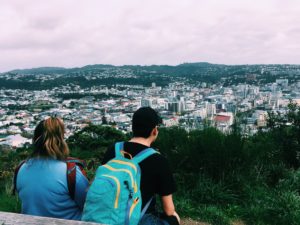Lauren Fenyes, the University of North Texas Special Learners in Oceania student blogger, writes: Kia Ora! Welcome to Wellington, New Zealand! After a long 15-hour flight, we have finally all arrived in the beautiful but very windy Wellington. Our first couple days in the city were spent orienting ourselves to the surrounding area. Several students and I hiked up Mount Victoria, stopping periodically to take in the gorgeous views.
On our first morning, many students took advantage of the local weekend market. This was a great opportunity to talk with locals and stall owners as well as catch a gorgeous sunrise! There were plenty of new foods to see, smell, and taste, including a delicious chocolate and raspberry crêpe that I enjoyed for breakfast. The market was full of color and life and was simply a wonderful way to experience early morning New Zealand life to start our first full day of the program.

After our first class session discussing what to expect during our time in New Zealand, I went with several students into the city to take a cable car up to a shuttle that delivered us to Zealandia, a sanctuary for New Zealand’s native wildlife. There we had a wonderful and informative walking tour and we hiked along the trails through the park observing indigenous plants and birds, such as the tui and pukeko, and more great views! We learned quite a bit about New Zealand’s history and the devastating impact foreign mammals had on the native wildlife when mammals were introduced to the island by Maori and European settlers.
Walking around the city, to and from the cable car, and to different restaurants, has been an effective way to experience city life an
d familiarize ourselves with the area. All the while, we are taking note of how these public spaces accommodate for individuals with disabilities. We continually check for accessible or alternative pathways for these individuals. This exercise heightens our own awareness of what is being done in society to adjust for those with special needs. Is there adequate space on the cable car to accommodate a wheelchair? Does the museum have an audio tour for those with visual impairment? Are the street signs and crosswalks adequately lit with flashing lights for someone who may not be able to hear traffic signals? These examples, and more, are considerations we take into account as we travel throughout the city. Our true involvement will start when we soon begin our visits to schools for students with special needs!








